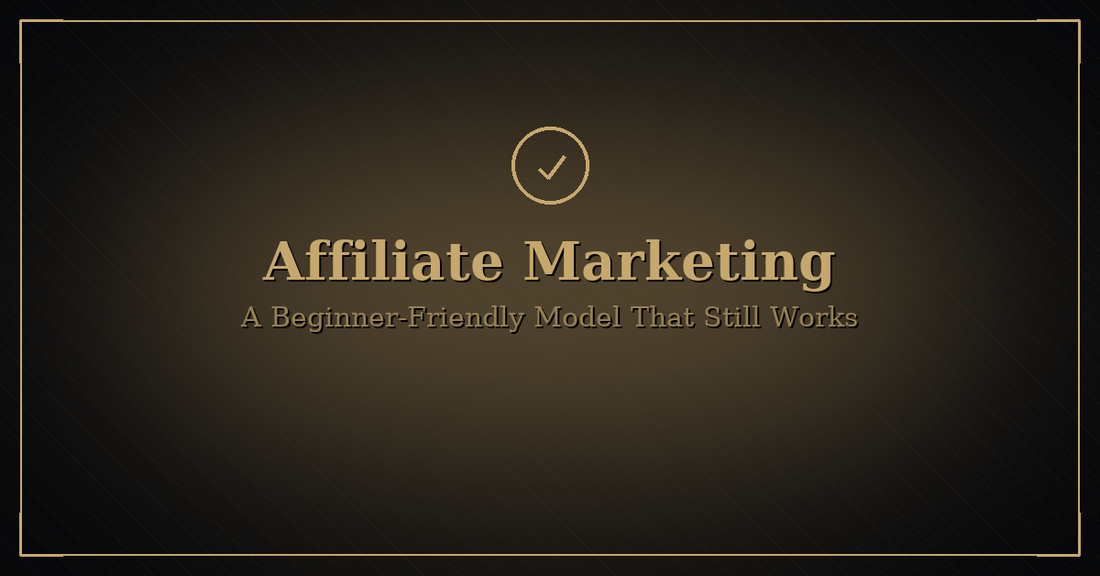
Affiliate Marketing: A Beginner-Friendly Model That Still Works
Share
Affiliate Marketing: A Beginner-Friendly Model That Still Works
Affiliate marketing still works in 2025—just not as a shortcut. When you treat it like a real business, it’s one of the simplest models a beginner can start: low upfront cost, clear steps, and compounding results. In plain English, affiliate marketing means you help a buyer choose the right product, they purchase through your tracked link, and the merchant pays you a commission. No inventory, no shipping, and no customer support. Your job is to publish helpful content that answers buyer intent and earns trust.
How affiliate marketing works.
You join an affiliate program, get special links, and place them inside content people search for when they’re ready to buy—reviews, comparisons, and “best for X” guides. When a reader clicks your link, a cookie or server-side tracking tells the store you referred the sale. If the purchase happens inside the program’s attribution window (for example, 24 hours or 30 days), you receive a commission. Programs vary: some pay a percentage of the order (CPS), some a fixed fee per action (CPA/CPL), and some offer recurring commissions on subscriptions. If you can choose, recurring commissions are powerful because they build predictable revenue.
When this model fits.
Affiliate marketing is ideal if you like explaining things clearly in writing or video and you’re comfortable researching a niche. It works best in categories where buyers compare before they purchase—software, tools, education, hobbies, finance. If you need money this week, pick a service model first; affiliate income grows as your library of useful pages grows and starts ranking in search.
What to publish.
Write for buyer intent. The phrases people type before purchasing are your map: “best [product] for [use case],” “[product A] vs [product B],” “[brand] review,” “[brand] alternatives,” and “how to choose [category].” A strong “best for” article gives quick picks by scenario, a clear buyer’s guide, and links to the exact product pages (deep links convert better than sending people to a homepage). A comparison piece explains who should buy A, who should buy B, and why. A review should include what it’s for, what it’s not for, real photos if possible, a short specs table, the pros and cons that actually matter, and honest downsides. Honesty increases conversion because people trust you to tell them when not to buy.
Trust and compliance.
Place a simple affiliate disclosure near the top: “This page contains affiliate links. If you buy through them, we may earn a commission at no extra cost to you.” Mark links as rel="sponsored" or nofollow. Mention alternatives, and say who should avoid a product. These small choices lift conversion rate because readers see you’re on their side.
The basic economics, explained simply.
There are only a few numbers to watch. Click-through rate (CTR) tells you whether your page and call-to-action make people click; conversion rate (CR) comes from the merchant and shows how many of those clicks turn into orders; earnings per click (EPC) is the money you earn per 100 clicks and is your practical “quality of traffic” score; revenue per session (RPS) is what you earn per visitor and is the best single number to compare pages. After 60 days, aim for EPC around €0.30 or more and RPS around €0.05–€0.10 or more. If EPC is low, fix intent match (target clearer keywords), link directly to the product, and make “who it’s for / not for” obvious. If clicks are low, your titles, meta description, or in-page calls-to-action need clarity.
A simple 14-day validation plan.
Start small and fast. In the first two days, choose one tight category and outline three pages: a “best for” list, a head-to-head comparison, and one in-depth review. Keep the promise of each page clear: what problem it solves and who will be happy with it. Over days three to nine, write and publish those three pages. Use plain language, add your own photos if you can, and include a short table that shows the few specs buyers actually use to decide. Add clear “Buy at [Store]” buttons that deep-link to the exact product. Over days ten to twelve, share useful snippets in a few relevant communities (Reddit, Quora, LinkedIn) where allowed, with value first and the link second. Send a small email to your list or friends asking, “Which use case should I compare next?”—that invites clicks without sounding pushy. On days thirteen and fourteen, check sessions, CTR, EPC, and the products that received the most clicks. If traffic is there but EPC is weak, improve fit clarity and link placement. If traffic is missing, switch to queries closer to purchase like “A vs B” or “best [product] for [use case].” One change at a time beats guessing.
How to pick programs that won’t waste your work.
Look for clear terms, fair commission rates, and cookie durations that match your niche’s buying cycle. Recurring commissions on software or memberships compound your effort. Avoid programs with frequent out-of-stock issues or vague reporting; both crush conversion rate and EPC. You don’t need dozens of programs—two or three solid ones per niche are enough to start.
SEO that actually helps readers.
Search engines reward pages that resolve a searcher’s problem. Use descriptive slugs, clear H2s that mirror your queries, a short buyer’s guide on each page, and internal links between your review, your comparison, and your “best for” list. Update top pages every quarter with current prices, availability, and better alternatives. Add one relevant outbound link to a credible source when it improves trust. Above all, write like a human guiding another human to a good purchase.
Common pitfalls to skip.
Thin content that repeats spec sheets doesn’t rank or convert. Sending people to generic category pages instead of deep links loses sales. Chasing only “best” keywords while ignoring comparisons leaves money on the table. And skipping email capture leaves you at the mercy of algorithms. A simple buyer checklist or mini guide grows a list that protects your traffic.
Where this leads.
The beauty of affiliate marketing for beginners is the compounding effect. Ten helpful pages become twenty, then forty. Rankings bring steady sessions, and sessions become a predictable drip of revenue. As you learn which pages drive EPC and RPS, you double down on them and prune the rest. It’s slow at first, then surprisingly stable.
Want a clear, beginner-friendly path?
Affiliate Marketing Mastery: Foundations explains how affiliate marketing works, the core models (CPS/CPL/CPA), how to pick a niche (evergreen vs. trends), where to find programs (Amazon Associates, Digistore24, ClickBank, Awin, CJ), how to set up your site and SEO, create content that converts (reviews, comparisons, tutorials, video), stay compliant (disclosures, GDPR, basic tax), and make your first sale with simple tracking and realistic expectations.
